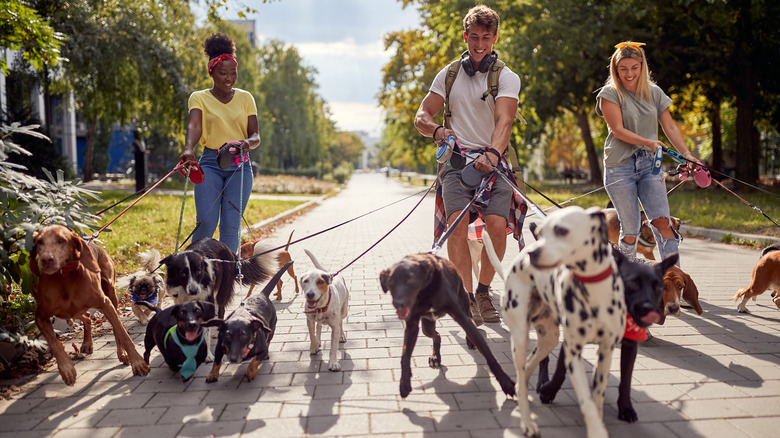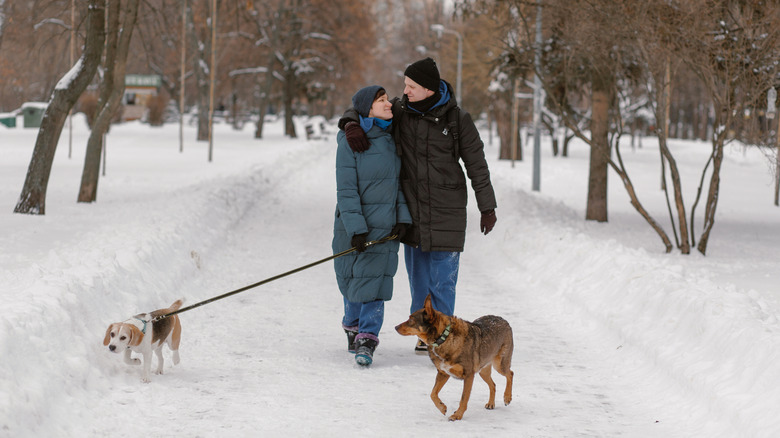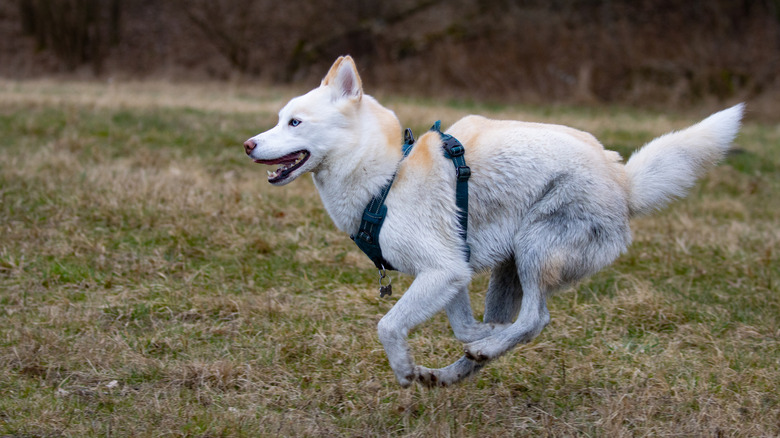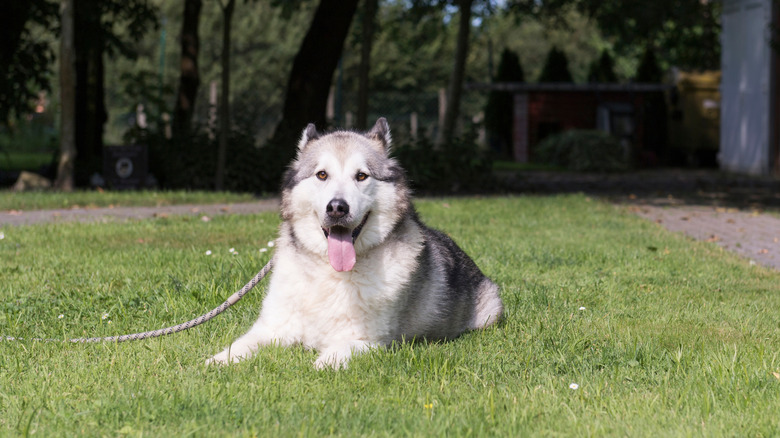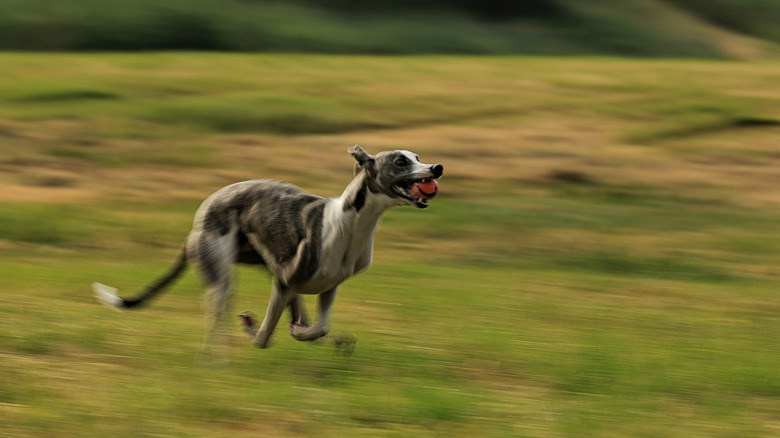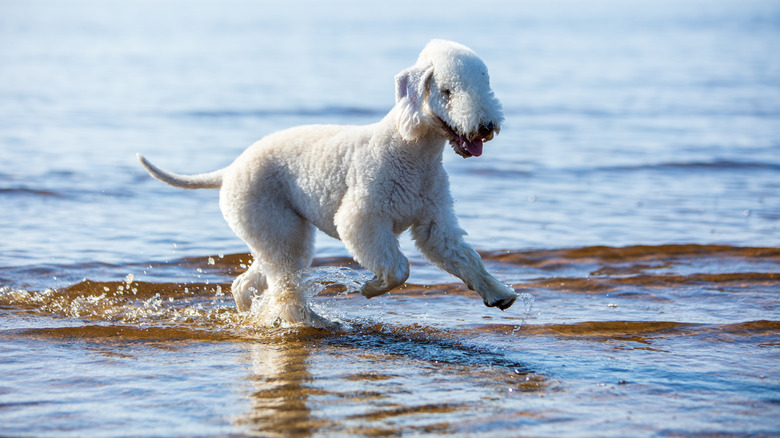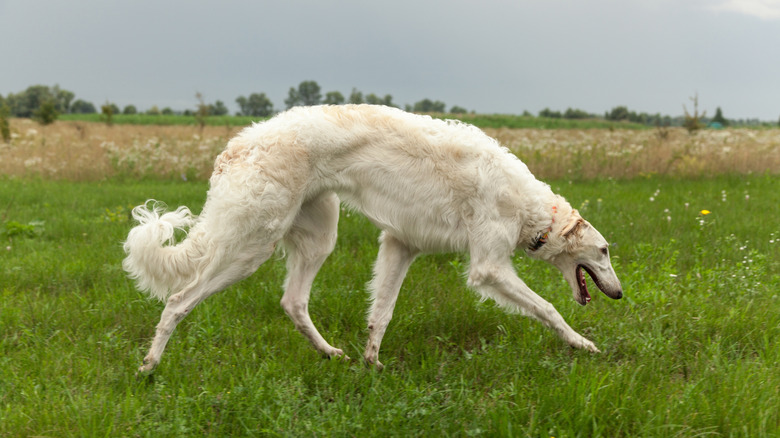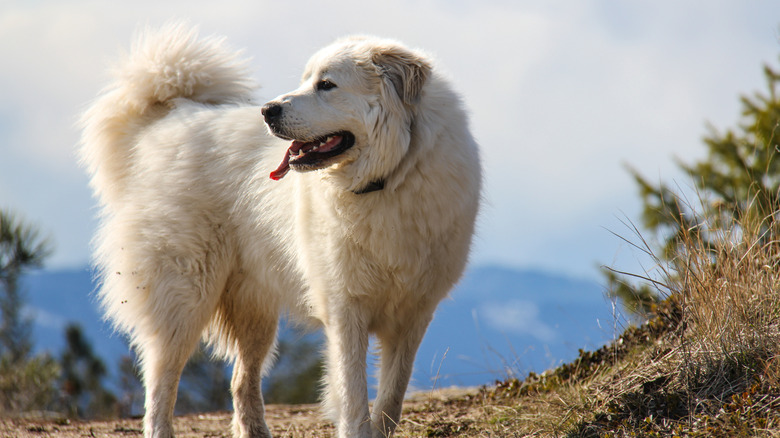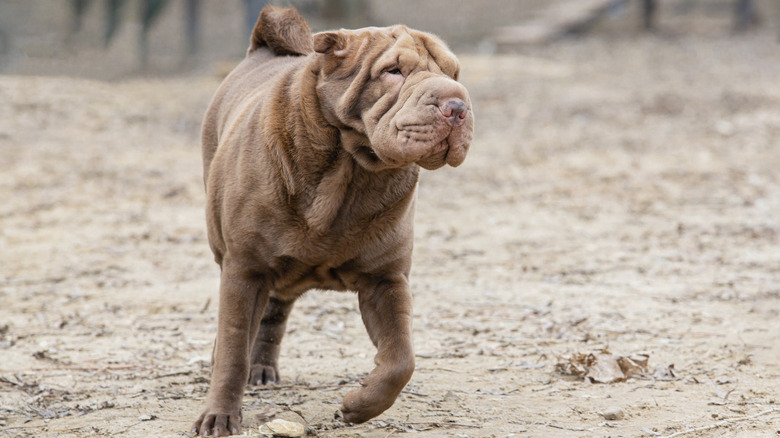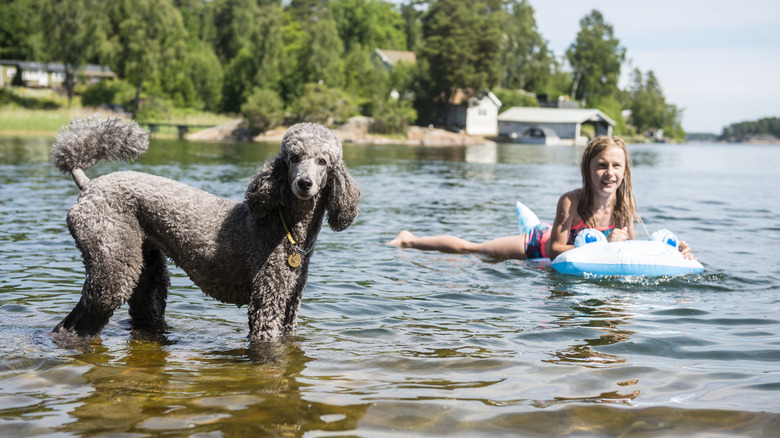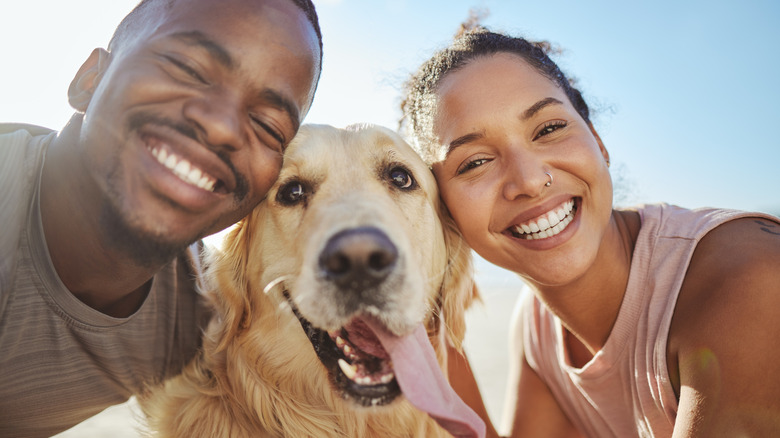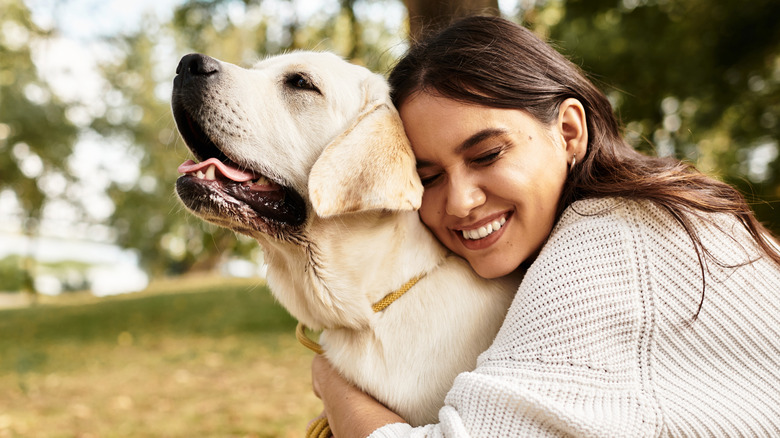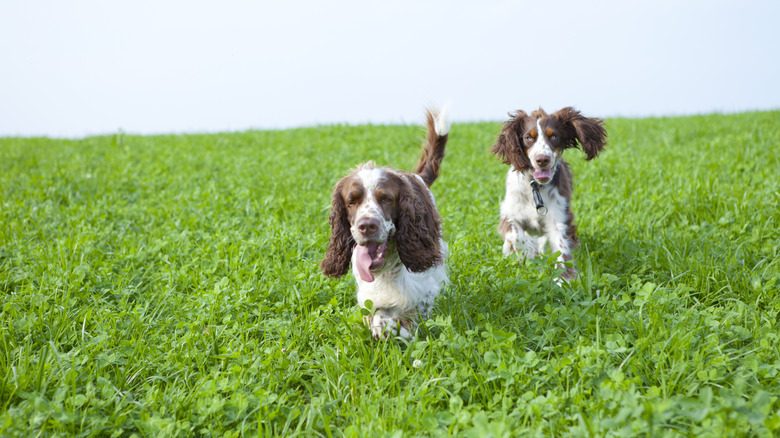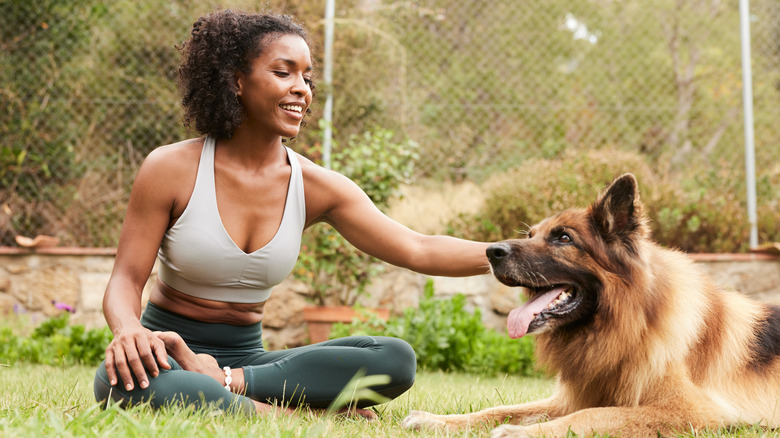8 Dog Breeds That May Struggle Without A Leash (And 6 That Likely Won't)
Who hasn't been on one side or another of the dreaded off-leash interaction, as a frantic dog owner hustles to grab hold of the dog they thought was firmly under voice control — until it wasn't? Maybe you've been out on your own when your off-leash dog suddenly darted off, startled by a loud sound or lured by something begging to be chased. Or perhaps you have a dog that is so eager to roam, it finds ways of escaping even a securely fenced yard in search of adventure.
Regardless, once you've been around the doggy block a few times, it won't come as much surprise that some dog breeds struggle more with minding commands or simply staying close while off-leash, while others are more likely to stay close and focused on you. It's also true that there will always be variations within breeds, from the occasional preternaturally calm bull terrier (yes, that really can happen) to the rare poodle who might still have a keen intellect, but chooses not to use it. It's hard to ignore certain breed-based trends. Not that we're looking right at you, beagles and huskies... but yes, we are looking at you, and some of your friends too.
Beagles tend to follow their nose when off-leash
Ah, the beagle: underappreciated songbird of the backyard, or never-appreciated escape artist? This cheerful breed can make a loving and loyal companion, but at the end of the day, beagles have been bred to follow their sensitive noses, which can pick up a scent in the air from a mile or more away. They're also bred to be pack hunters so, if your beagle isn't scooting off on its own in search of some far-off scent, it might be off in search of hunting buddies — or optimistically casting about for an airborne scent that it hasn't picked up yet, but knows must be out there somewhere.
Beagles are known escape artists, famous for wiggling out of collars and even some harnesses, so it can take a lot of trial and error to figure out what keeps your beagle from suddenly taking off on its own to find the source of some elusive smell. Beagles are also excellent diggers and, despite their small stature, athletic enough to use lawn furniture or other objects as "stairs" to help them get up and over a fence. So, if you let your beagle out in the yard on its own, be alert to opportunities for it to dig or bound its way to freedom.
Huskies are bred to run free when off-leash
For all their physical differences, huskies and beagles have a lot in common: They're famous escape artists, often vanishing from behind seemingly impenetrable fencing, and they're very talkative about their adventures. Huskies have been known to dig beneath fencing, go right over the top of surprisingly tall fences, and even chew through wire fences, so you're going to need to use some of the same measures you'd employ to keep your dog safe from coyotes, such as having a tall enough fence.
While beagles are bred to follow scents, huskies are bred to run — and they have an incredibly high prey drive that manifests as an urge to chase anything and everything, including small animals and cars. Huskies are also prone to heading off on adventures on their own once free of a fence or leash. Siberian huskies can reach a top speed of 30 mph, meaning once they're off, you may be hard-pressed to keep up with them in order to reattach their lead. Despite their different builds and psychologies, the key to keeping both breeds close by is diligent supervision, obedience training, and copious amounts of exercise — because if they've already burned off most of their energy, they will be much less likely to roam.
Alaskan malamutes are independent roamers when off-leash
The powerlifters of the working dog world, Alaskan malamutes were bred to carry or pull heavy weights for long distances. If they decide to take off while off-leash, they can cover a lot of ground — and if they decide they don't want to stay behind a fence, they're liable to dig underneath it or climb straight over.
However, the biggest challenge in keeping an off-leash malamute close is its famously strong-willed and independent mind. Keeping these gentle giants in check requires diligent training and lots of physical exercises and mental exercises suitable for dogs, so they don't feel the need to roam in search of stimulation. In addition to the usual obedience work and dog games like fetch and tug, your malamute might enjoy being trained to pull a sled or enter weight-pulling contests.
However, even a satisfied malamute is still prone to roaming. At the end of the day, your only sure option for good off-leash behavior is, well, to never let your malamute off leash unless it's in a contained area. Even getting your malamute to walk comfortably on a leash can take some practice and training, because a dog that's been bred to pull sleds is typically eager to pull on a leash, too.
Greyhounds are natural racers when off-leash
What kind of dog runs even faster and more eagerly than a husky? Greyhounds, that's who. Speed is literally in their blood, and greyhounds who've been exposed to racing are trained to ignore everything around them while running — including their owner's frantic efforts to recall them. With a maximum speed of about 45 mph and acceleration so fast it only takes them a few steps to hit that maximum, the ideal time to let your greyhound off-leash in an unenclosed area is never. They're sighthounds and even if you don't see something worth chasing in the area, they might.
Ultimately, the rule for greyhounds is that they should never, ever be off leash in an unenclosed area. Even greyhounds that aren't exposed to racing have been bred for high energy and athleticism, so keeping them physically and mentally engaged is critical for ensuring their happiness. Interactive toys and puzzles are a good start for the mental part of the equation, but your greyhound also needs lots of exercise, whether that means dashing around in a fully enclosed dog park, long games of fetch in the (you guessed it, fully enclosed) backyard, or going with you on errands — safely on leash, of course.
Bedlington terriers have strong prey drives when off-leash
If you find yourself thinking that a well-groomed Bedlington terrier looks like a battle droid from Star Wars, you're not alone — there is a very strong resemblance. For all their unusual, vaguely poodle-like proportions, these charming, cheerful hunting dogs are fierce workers with a very strong prey drive. That means that, unless you keep your Bedlington on a leash, it's prone to take off chasing squirrels or other small creatures. After all, its ancestors were originally born and bred to hunt vermin, so from your dog's point of view, those mad dashes are simply it doing its job.
Bedlington terriers are highly social with their people, so lots of together time, frequent exercise, and consistent obedience training may help them ignore whatever small creature has caught their attention. But more realistically, your average Bedlington's instincts will be to keep going until it gets its quarry, then check back in to see what the outside world is doing — so you can save yourself a lot of heartache by keeping your Bedlington firmly on leash unless it's in an enclosed area.
Borzoi are swift sighthounds when off-leash
It's no coincidence that the borzoi, whose name means "swift" in Russian, looks a lot like a greyhound. This dog's lean build and long legs help it reach top speeds of 35 to 40 mph and, being a sighthound, your dog might chase cats or other small creatures. Its ancestors were used to hunt prey as large and fierce as wolves. A dog that fast and focused is almost impossible to catch once it's running free — so the best approach is to not let that happen in the first place.
The borzoi simply isn't the ideal dog to let free, especially since a tendency toward a stubborn, aloof, and independent nature can make it a little harder to train for recall than your average dog. However, they can excel at lure coursing and agility trials, and their intelligent brains will benefit from interactive toys and lots of regular training — even if they simply aren't bred to have the best recall. Your borzoi also needs an opportunity to indulge its instincts to chase and run so, unless you're prepared to regularly run with it on a leash, your dog will benefit enormously from a fully enclosed run where it can let its energy out.
Great Pyrenees are protectors when off-leash
At the opposite end of the doggy athletics spectrum, the Great Pyrenees can easily reach 100 pounds and are undeniably of a much sturdier build than their greyhound and borzoi cousins. Although there's no risk of these fluffy giants darting away from you at greyhound speeds, they have a broad independent streak and are prone to wandering. That probably harkens back to their ancestry as protectors of livestock flocks, with a fluffy white coat that helped them blend in with the livestock until marauding predators found out that some of those sheep had sharp teeth and a fierce protective instinct. Nowadays, the breed's independent, wandering streak means that if you let it off-leash, it will only come back when it's good and ready. Pyrenees are trainable, but only when they feel like complying, so you simply can't count on their recall.
Great Pyrenees are also quite likely to disregard underground electric fences, and their protective instincts can lead to aggression if they're left tied up. Your Pyrenees needs to be free to patrol its territory, so it's up to you to make sure a reliable fence is installed and, just as importantly, that any gates are kept closed to prevent it wandering off in search of a flock to protect.
Shar-peis have wary, independent natures when off-leash
Anxiety, thy name is shar-pei. Much like the amiable Great Pyrenees, the shar-pei is a natural-born protector, with an intelligent, loyal mind and a broad independent streak that helps it function independently as a guardian for people or livestock. However, the shar-pei's protective instincts and tendency toward anxiety can lead it to be naturally suspicious of strangers, which can translate into reactivity if it's not consistently socialized and trained, starting early and continuing for the rest of its life.
A well-socialized, well-trained shar-pei can be a wonderful, loyal companion — but its willful nature and independent streak means that even the best-natured shar-pei may have sketchy recall at best. All these pieces come together to indicate a dog that's at its best when on leash or in a safely enclosed space. Shar-peis can also excel at agility, tracking, and even obedience training, as long as you find an activity the dog genuinely enjoys and work with it consistently. As with any breed, that investment of time and effort will pay off in spades for both of you — but it goes doubly with a breed like the shar-pei, which depends on its humans to help it develop into the best version of itself.
Poodles are intelligent with great off-leash recalls
For all their reputation as a "fancy dog," perhaps due to the varied grooming cuts you'll see used on a poodle to keep its curly coat in good shape, the poodle is an enormously intelligent and highly trainable dog. That doesn't mean the poodle will automatically know to stick close while off-leash or come back to you when called. However, if you take the time to train it, every variety of poodle — from toy to miniature and the "full-size" standard poodle — is likely to stay focused on you and quickly grasp which behaviors you're looking for.
That makes training your poodle to come when called a relative breeze, although you might still want to invest in some professional training sessions — more for you than for your poodle, as many dog owners benefit from learning how to most efficiently communicate desired behaviors to their dogs, or how to use positive reinforcement training in place of the negative reinforcement they may have seen modeled elsewhere. A professional trainer can also help you spot any places you might be unknowingly lapsing in your consistency, creating confusing feedback for a dog that is so smart, it's likely to be cued in to even your smallest changes in mood and behavior.
Golden retrievers have strong recalls off-leash
Although golden retrievers may have a bit of a reputation for being air-brained thanks to their outgoing, joyous nature, goldens are, in fact, very eager to please their people. That, in turn, makes them easy to train. The golden retriever's easygoing personality and eagerness to bond with you means that with just a bit of well-timed praise and rewards, you can have a dog that reliably comes back when called, even if you've let it off-leash.
Of course, that doesn't mean you shouldn't train your golden retriever to walk well on a leash, too — this is a necessary and useful skill for any dog — or explore other ways that you can stimulate its mind and body for the happiest life possible. As you might expect for a dog that's bred to skillfully retrieve fallen upland game, the golden retriever is likely to enjoy anything related to retrieving. Their intelligence and sweet nature also make them excellent service and therapy dogs, and as long as you put in the required effort, goldens can excel at obedience training too.
Labrador retrievers will come when called off-leash
Much like golden retrievers, Labrador retrievers are friendly, sociable, and very interested in engaging with their humans. Labradors tend to jump wholeheartedly into any job they're given — including being excellent at recalls if trained properly. Like their retrieving cousins, Labradors instinctively desire to bring items back to you, making it easy to turn this behavior into an off-leash recall. That natural instinct combined with an eagerness to please translates into easy training for many other off-leash behaviors, too.
Also like golden retrievers, Labradors need regular mental and physical exercise to help them be at their best. If you don't give your Lab a job to do — whether that's regular games of fetch in the water they so love, or even the service work they often excel at — it might just create its own job, which could include relocating items around your house that it decides need to be "retrieved."
Border collies love a job, including off-leash recalls
The border collie's intelligence and trainability are nothing short of legend. This whip-smart dog can, quite literally, be trained to do almost anything, which makes off-leash recall, heeling, and other obedience behaviors a breeze. However, all that intelligence and drive can be a double-edged sword, because your border collie requires intense, consistent engagement from you to be its best self, and you might find yourself working hard to stay a step ahead of this canine Einstein.
A bored border collie that isn't being put to work on suitable tasks will create its own entertainment, which might include destructive, territorial, or reactive behaviors, or herding things that actually shouldn't be herded — whether that's children in the house or cars on the street. While border collies can do incredibly well off-leash, ultimately their success will depend on how much energy and attention you put into the relationship. When properly engaged these dogs will excel at almost any dog sport you enter them into, and be enthusiastic companions for all your athletic endeavors — on or off leash.
English springer spaniels excel at being off-leash
Some hunting dogs, like the Bedlington terrier and the borzoi, have been bred to an independent temperament that makes them less likely to have effective recall and off-leash behavior. Or consider beagles, which have been bred as pack hunters and might just run off to join any "pack" within range of their senses. However, the English springer spaniel has a more dutiful nature which, combined with its intelligence and natural friendliness, makes it much more likely to become a reliable off-leash companion.
Bred to be bird dogs, an English springer spaniel that holds its traditional "job" works more closely with humans than its independent-minded counterparts. That helps with its trainability, but if you're not a hunter, you'll need to make deliberate choices to be sure your springer spaniel gets plenty of exercise and mental engagement. The springer craves time with you, so this is an excellent breed for people who want to exercise along with their dog — which also positions you perfectly for consistently rewarding good behavior off-leash.
German shepherds are reliable companions off-leash
There are few dog breeds better known for their intelligence and loyalty than the German shepherd — characteristics that can make recall and off-leash training a breeze. However, much like border collies, the same mentality, physicality, and instincts that make the German shepherd so easy to train also put it at very high risk for unwanted behaviors if its humans don't properly socialize it and engage with it. This isn't necessarily the best dog for a novice handler or someone who isn't physically strong enough, or who doesn't have the time, space, and energy to accommodate the German shepherd's innate size, strength, and high energy.
However, for those who understand the German shepherd dog's needs, you couldn't ask for a more loyal, loving, or obedient companion. Frequent engagement and exercise with you will help keep their recall skills sharp, and a well-trained German shepherd makes a splendid protector for your family and home.
Regardless of breed, training is key to ensuring your dog does well off-leash, as even the best dog can still run into issues. Consistent training, patience, and lots of love can ensure that the happiest beagle and fluffiest golden retriever remain calm and safe on or off leash.
